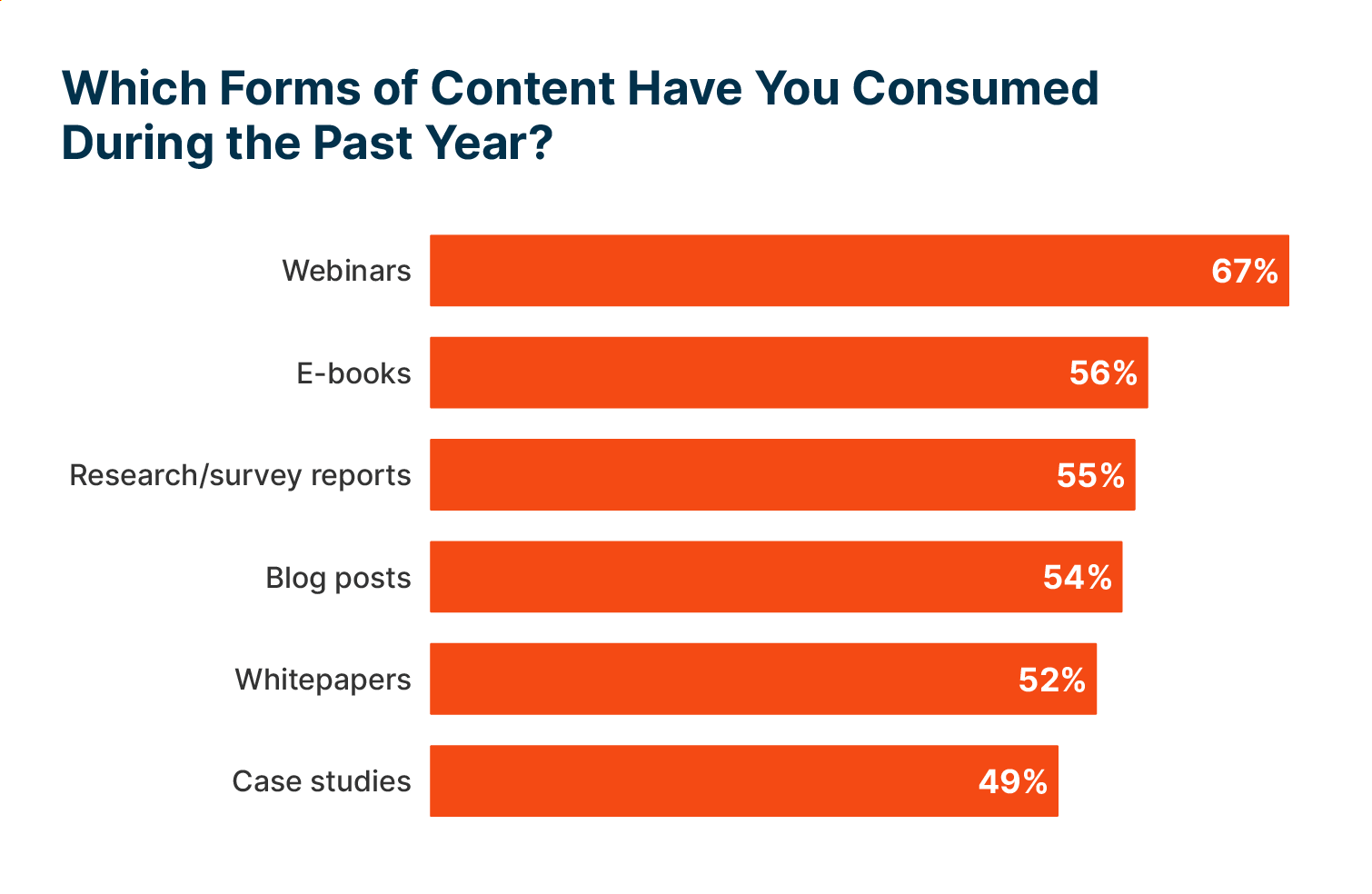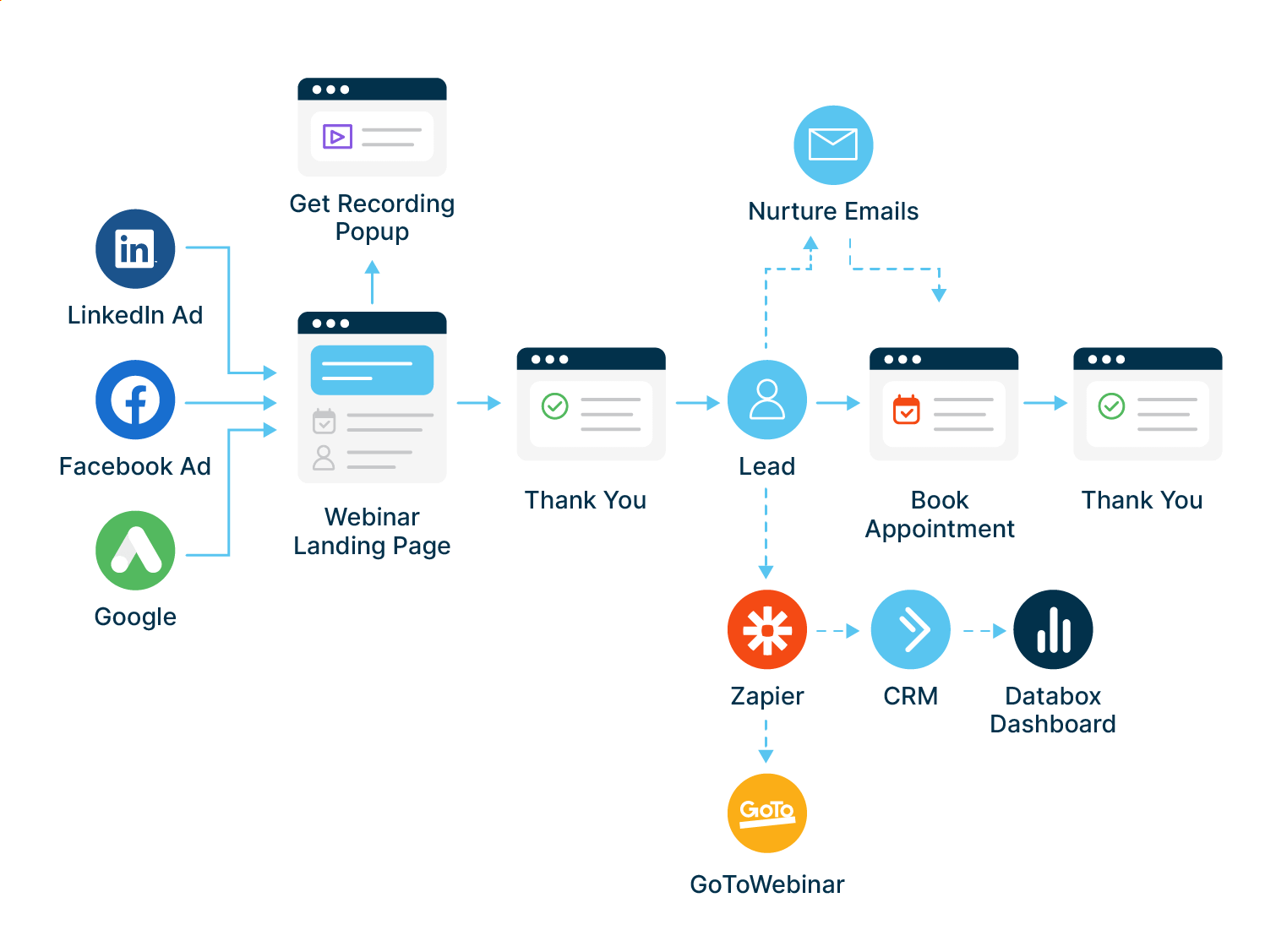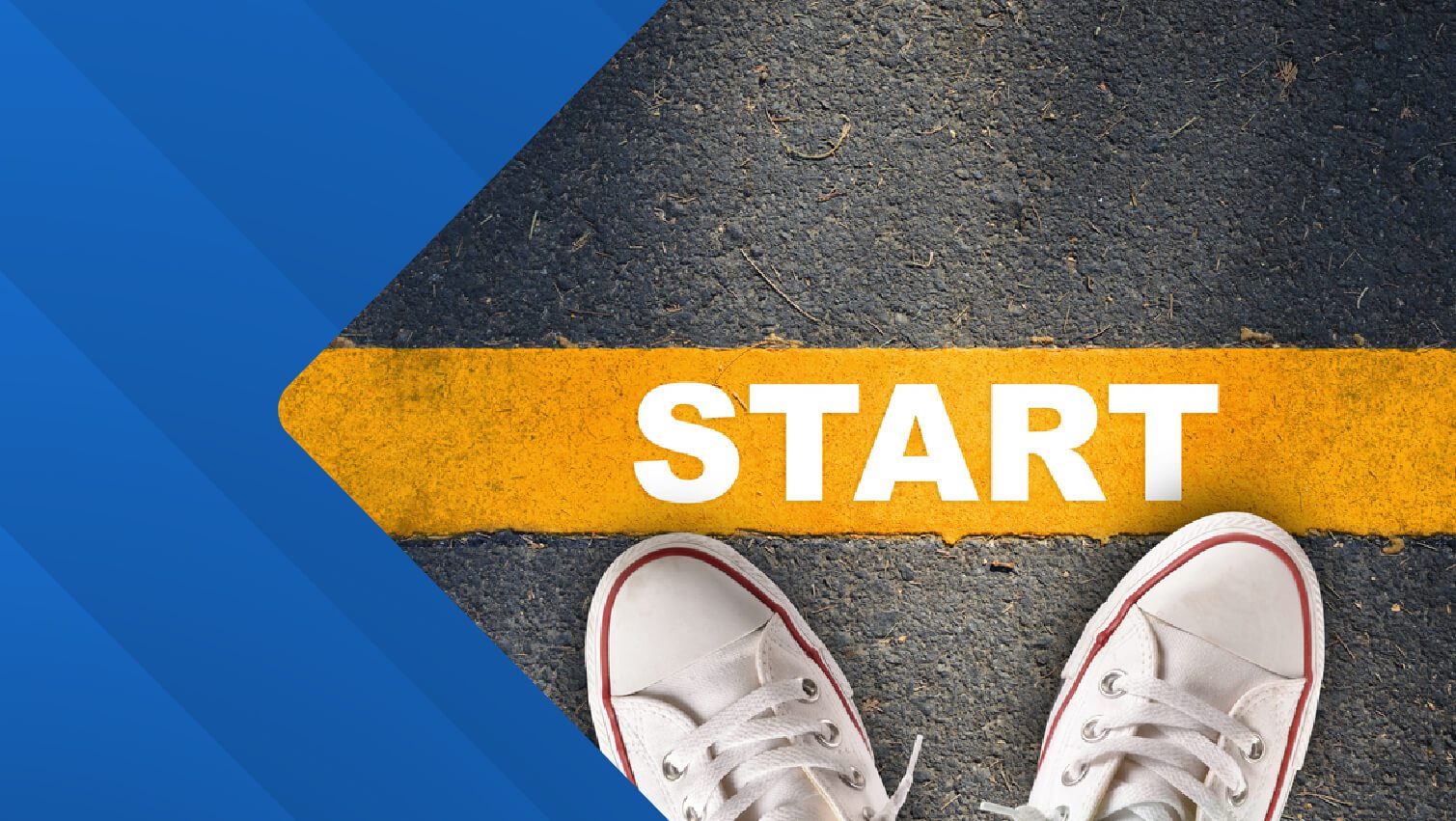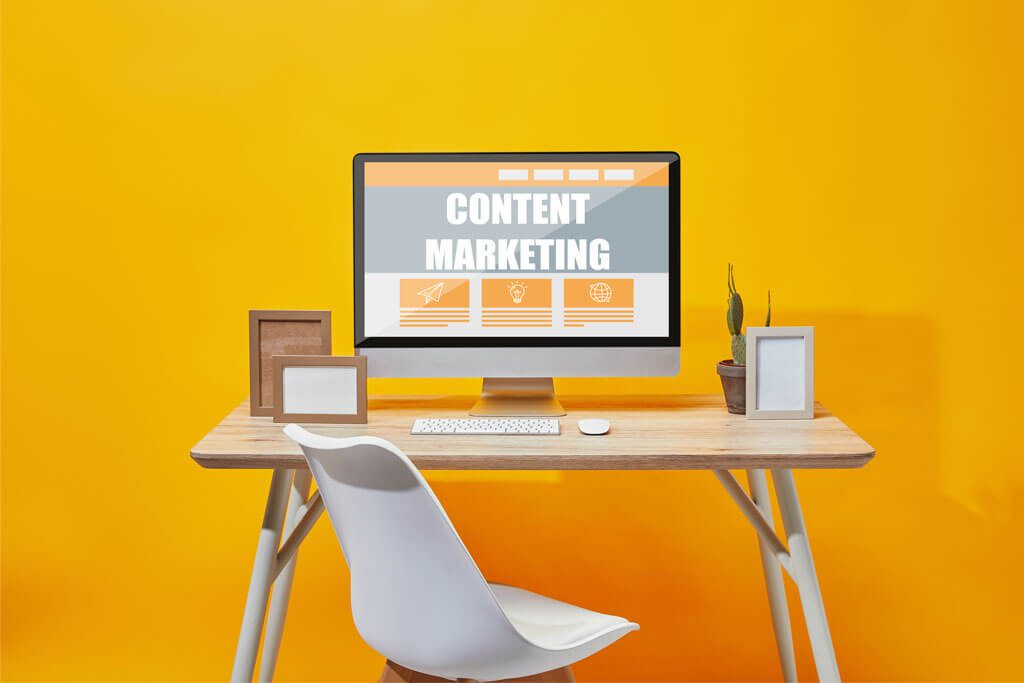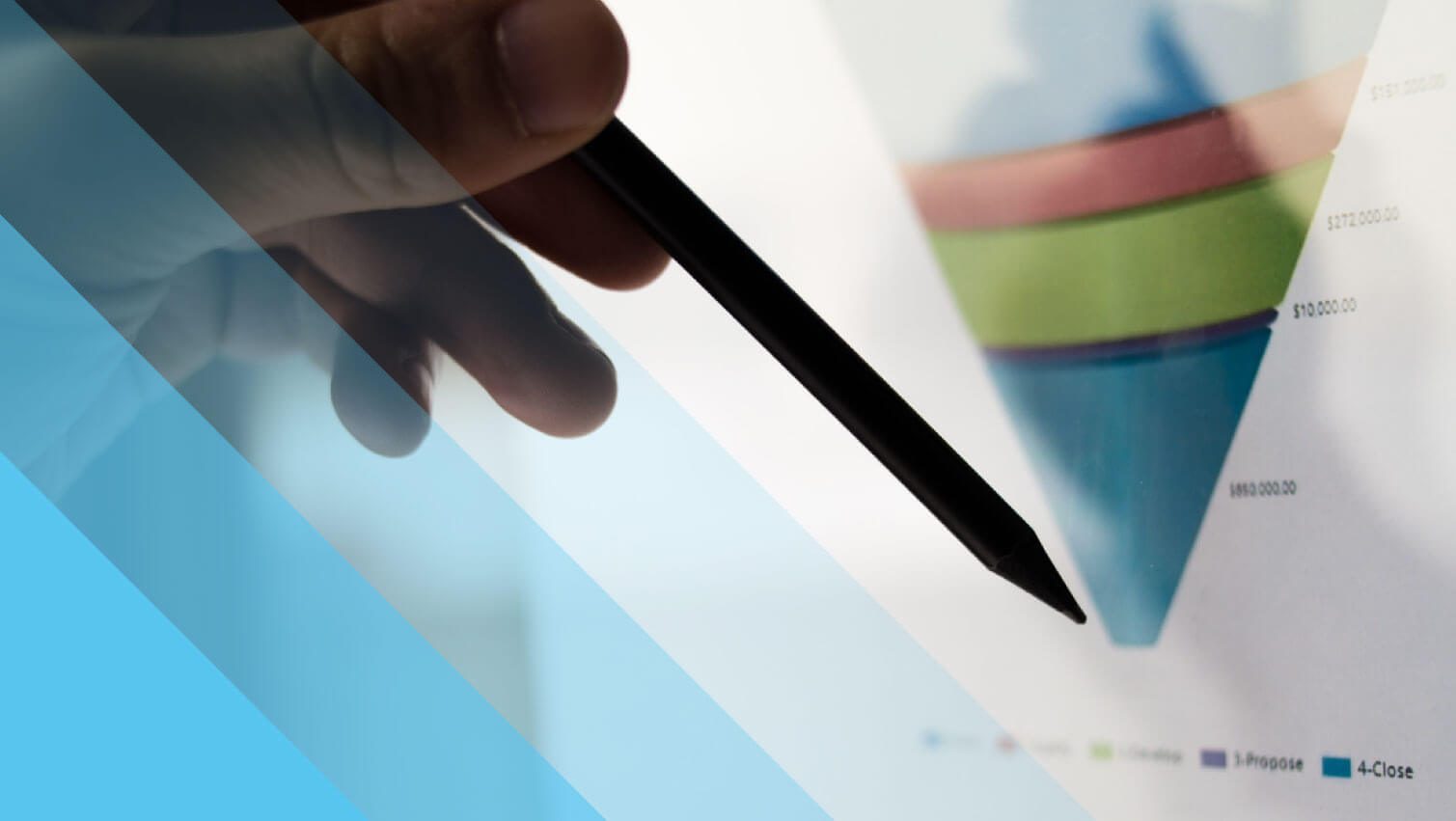Webinars have emerged as one of the top tactics for lead generation in the B2B space—67% of buyers have consumed them in the past 12 months, and 40% say they use them specifically to inform purchase decisions. They align with general consumer preferences for video content and offer an opportunity for B2B sellers to reach a large audience with a single event.
Other important benefits of webinars include:
- The chance to establish thought leadership and expertise
- Direct and live engagement with potential buyers
- Brand awareness and a platform to promote products and services
- An opportunity to collect first-party data from registrants
All that said, webinars take time to produce and execute—and the full webinar lead generation opportunity encompasses not just the event itself but the time leading up to and following it.
To earn full return on investment (ROI) from your webinar efforts, you’ll want to set up an end-to-end webinar funnel that pulls leads in, motivates them to take action, and converts them to sales (then does it again and again for your business over time).
If you’re ready to launch webinar funnels that are highly automated, generate best-fit leads, demonstrate your expertise, and enable you to scale your webinar lead gen strategy, you’re in the right place.
In this all-encompassing guide, we’ll define webinar funnels, walk through how they’re executed in practice, and cover actionable steps you can take to launch one for your business.
Quick Takeaways:
- End-to-end webinar funnels require action before, during, and after your event
- Funnels can be built for live webinars and webinar recordings
- Webinars should be planned around well-researched audience interests and needs
- Pre-event and post-event email sequences (with compelling CTAs) are critical to keeping leads moving down the webinar funnel
- Webinar recordings turn into high-value, highly shareable post-event content assets
- Your sales team should be looped in on your webinar funnel strategy and webinar schedule
- Automation enables evergreen webinar funnels that generate leads without requiring manual intervention
What Are Webinar Funnels?
When you think of a “funnel” as it relates to the B2B world, you might think of a straightforward marketing or sales funnel.
However, the kind of webinar funnel you want to create for your business is a bit more complex than that—it involves a multitude of steps before, during, and after your event, and some that depend on the specific actions of your registrants and attendees. Here’s an example to show you what we mean:
Let’s walk through this example funnel from left to right.
First, you see the webinar promotion happening through social media and ads. Potential buyers show behavior that tells algorithms they’d be interested in your event and as a result they see your advertising content. You can also promote your webinar directly to your existing audiences by emailing them, posting on social media (non-ad content), and creating other promo content (like a blog post).
Next, you see the webinar landing page and webinar recording pop-up. That’s because this funnel is for a pre-recorded webinar, meaning it already happened. Webinar registrants get immediate access to watch the replay. For a live webinar funnel, you’d see steps for registration confirmation and reminder emails leading up to the live webinar date and time.
During a live webinar, you’ll also see action steps for interactive tools to make your webinar more engaging—things like polls, survey questions, live chat, and Q&A time that help attendees become active participants and build connection with them as individual potential buyers.
Your registration list is now also your list of potential webinar leads. You’ll want to send follow-up nurture emails to thank them for their interest, provide additional resources, collect feedback, and direct them on next steps toward purchase. This goes for everyone who registered for the event—attendees that stayed for the entire event, those that came and left early, and even those who didn’t end up attending at all.
You’ll also see in the example above that leads should be formally added to your pipeline by being entered into the software systems you use during the sales process—your CRM, for example, or email marketing platform. Ideally, this happens automatically when a registrant signs up for your event and data is integrated across the tools you have in place.
Finally, you’ll see that the webinar funnel rounds out with leads interacting with your sales team and ultimately making a purchase. Follow-up and nurturing communications should all be aimed at this goal—getting leads to take steps like booking a demo, scheduling a meeting with a sales rep, or requesting a price quote for their business.
How Do You Set up a High-Performing Webinar Funnel?
Plan Your Webinars
A webinar funnel is driven by interest, which means it starts with planning webinars on topics your audience cares about. There are plenty of helpful places to turn and resources to use to research your audience interests and even ask them what they want to learn about, including:
- Social media: Check out which posts/topics are getting the most engagement, and/or conduct polls asking your followers what type of webinar they’d be most interested in
- Your blog: What topics are your web visitors reading about most? This can inform which topics you should cover in your webinars
- Customer support: What are your customers asking for help with? Ask your customer support team to find opportunities for “how-to” or problem-solving webinars
- Sales data: If you’re looking to run product webinars, look at which products your customers are buying (and which might need a boost from webinar content)
In short, keep in mind during the planning stage that your webinar should have a purpose. It should fit with interests, preferences, and needs your audience is already demonstrating. If you feel you’ve identified a topic you can’t totally cover yourself or that would be enhanced by another perspective, consider partnering with another organization in your network to get the subject matter expertise needed for the best-quality presentation.
Once you’ve aligned your topic accordingly, secured your experts, and come up with a title, you can finalize logistics details like day and time.
As you plan more webinars and begin to execute a long-term strategy, you may want to plan your entire webinar schedule for the next few months (or even the full year) at one time (while leaving flexibility for added events when new opportunities arise).
Create Your Webinar Landing Page
Your webinar landing page is the hub of your webinar—the place where it lives at every stage of the event (before, during, and after it happens). Creating a killer landing page can be what makes or breaks the success of your webinar—you can forget about building a webinar funnel without one.
The goal for your webinar landing page should be to make it a one-stop shop where interested potential attendees can learn everything they need to know about the event, including:
- Title, topic, and featured hosts/speakers
- Date, time, and location
- Topic description and speaker bios
- How to register
Your registration form should be placed prominently on the page and be kept short and sweet so that attendees actually complete it. Only collect the essential information you need at the time of registration (i.e., name, email, company, and position, for example); remember, you’ll have more opportunities to learn about your leads later on.
Do everything you can to grab attention when someone arrives on your landing page (think clean, aesthetically pleasing design and compelling above-the-fold copy) and take steps to make sure they don’t leave your page without actually registering for the event (exit pop-ups and having multiple CTA buttons are two effective strategies).
Promote Your Webinar
Now you’ve got the foundation in place, and it’s time to fill your webinar funnel with interested potential attendees and high-intent leads. The key here is to know who you’re targeting (don’t try to make every webinar for everyone) and meet them where they are with exciting promotions.
The wider your promotional reach prior to your event, the fuller your funnel will be (and the more sales you’ll be able to convert at the bottom). It’s essential to take a multichannel approach, ensuring the right audiences see your event wherever they engage with your brand.
Here’s a list of high-ROI strategies to boost visibility of your event:
- Content assets: Create a suite of promotional assets like social media graphics, post templates, and banner images, that make it easy for you (and others) to share the event
- Partner promotion: Encourage speakers and other partners in your network to promote the event to relevant audiences
- Blogs: Write blogs leading up to your event around the topic, and include event details in your articles
- Direct outreach: Execute a pre-event email sequence inviting your engaged audiences to the event and linking directly to your landing page to register
- SEO: Optimize all of your content materials (including your landing page) for SEO so you reach anyone searching for relevant topics or terms
- Display ads: Target paid ads to your most important audiences (and retarget those who visit your landing pages and/or blog articles, etc.)
Collectively, these tactics grow your webinar funnel by building momentum around your event and boosting the number of people who know about it before it happens. Given that every event experiences attendee melt to some extent, it’s essential to cast the widest net possible (while staying targeted in your approach) to earn a high number of registrants.
Execute the Event
The way you execute your event plays a central role in how well you keep your webinar funnel moving. There are two keys to making it effective:
- The right webinar platform: An all-in-one platform centralizes your webinar planning and execution efforts and ensures the technical aspects of your event run smoothly
- Data collection capabilities: Most platforms do this automatically, but be sure you can collect data on which registrants actually attended, plus how long they stayed
In addition to automatic attendee data, also consider ways to collect engagement data and learn from your attendees during and after the event with tactics like polls, survey questions, live chat, and Q&A sessions.
Send Follow-up Email Sequences
The data you collect during your event is important to the next stage of your webinar funnel—follow up. Segment your registrants by whether they attended your webinar or not, and send them separate messages directing them to the right next step. In most cases, this means sending non-attendees to your webinar recording and attendees to the next step in your sales process.
We’ll discuss both of those in more detail next, but for now, let’s focus on the timing and execution of your follow up. Best practice is to follow up with your registrants within 24 hours of your event to say either “Thanks for attending,” or “Sorry we missed you.”
Automating these emails is your best bet—you can have them written before your event even happens, add your segmented lists after, and trigger your automated follow-up sequence so you don’t have to do any extra manual work.
Other things to include in your follow-up emails:
- Links to additional resources on the topic and/or your products and services
- Sales team contact information and next step CTAs
- Related and relevant content (think blog articles, other webinars, e-books, and so on)
Make your emails concise and straight to the point—to keep your webinar funnel full and moving, you only need a hook (like your recording or other content asset), short but compelling copy, and a clear and prominent CTA that tells your recipient what to do next.
Leverage Your Recording
Your webinar recording plays an important role in keeping your funnel moving after your webinar ends. It gives non-attendees a chance to view the webinar and catch up in the sales process, and it provides you with an asset you can share across channels and with new audiences over time.
Maintain your webinar landing page after your webinar ends (as is visualized in the example webinar funnel image we looked at earlier) to power post-event webinar lead generation. Instead of sending new registrants a confirmation and link to the live event, simply send them the video recording link.
After that, you can trigger a nurture email series just like you would for live event registrants and attendees.
Be Intentional About Your CTAs
Your webinar funnel strategy should align with your larger sales process, which means your CTAs should be intentional. Take time to align your marketing and sales teams and identify at every stage of your funnel what you want your lead to do next.
An obvious one is that after they register, you want your lead to attend the webinar. You include it in your pre-event CTAs and send reminder emails. But what about after?
Post-event CTAs to power your webinar funnel could include:
- Watching/reading additional content
- Scheduling a demo
- Scheduling an appointment with your sales team
- Sharing additional information
- Attending a follow-up webinar to the previous one
These are just a few examples. The key is to make your CTAs consistent and intentional—as you run more webinars, always use the same process to boost sales team execution and success.
Prepare Your Sales Team
Speaking of your sales team—when you’re launching a webinar funnel strategy, you’ll need to get them on board. Not only is it considerate, but it’s critical to the customer experience for a few reasons.
First, if you succeed in generating leads and getting them to take action, your sales team should experience an influx of new leads at certain points in your funnel. Second, your leads will expect your sales team to understand the experience they’ve had with your company so far and refer to it as needed.
Keep your sales team abreast of your funnel strategy (creating visuals and reference documents can be helpful to this end) and make sure your webinar schedule is on their calendars.
Adopt the Right Tools To Help You Execute
We mentioned most of the important tools already—like your CRM system, webinar platform, and email marketing software. Be sure you have these (and any other) tools you need to power your webinar funnel strategy in place at the start, and integrate them wherever possible for seamless data transfer and consistent, real-time views into your sales pipeline.
Automation: They Key To Webinar Funnel Success
As you may have noticed, automation is a key theme prevalent across the stages of the webinar funnel, as well as the tools and tactics you’ll use to execute it. Its benefits are numerous in both driving efficiency and boosting ROI.
Perhaps its most important benefit of all is that it enables evergreen webinar funnels—those that continue to drive leads and sales over time without requiring manual intervention.
As you grow your webinar lead generation strategy and implement multiple funnels at once, you’ll need these evergreen funnels to maintain sales team bandwidth, keep things consistent, and have the ability to quantify specific tactics (and the ROI they earn).
For example—when the same email marketing automation tool sends the same email sequence at the same intervals after every webinar, you can confidently measure the effectiveness of that tactic in the form of conversion rates or direct purchases made.
Similarly, when you automate retargeting ad promotion with the same strategy and timing leading up to all of your events, you can get an idea of how many registrations it’s yielding you (on average) by tracking traffic from your ads to your webinar landing page.
Automation also levels up your data analytics strategy, eliminating human error from data entry, allowing you to quickly obtain insights you need to continuously improve your strategy.
Generate More Webinar Leads with ActualTech Media
When it comes to building webinar funnels that win you new customers, ActualTech Media can do much of the work for you. We connect B2B tech marketers directly to capable, motivated audiences in hot-topic, multi-vendor industry events. We handle the setup and promotion, and you can expect anywhere from 200 to 1,200+ high-potential leads in return for participating.
Ready to learn more? Get in touch with our team today!


















